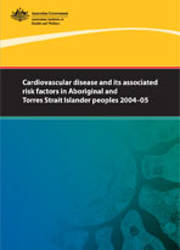Summary
This report updates national-level information for Aboriginal and Torres Strait Islander peoples and non-Indigenous Australians on the prevalence of cardiovascular disease and exposure to its associated risk factors, as well as on cardiovascular deaths. Results are based mostly on analysis of the Australian Bureau of Statistics’ most recent National Aboriginal and Torres Strait Islander Health Survey and National Health Survey conducted in 2004–05.
Key findings
Cardiovascular prevalence, deaths and risk factors are high in Indigenous Australians
- In 2004–05, one in eight Indigenous Australians had cardiovascular disease as a long-term condition. The disease was more common in women and in older people.
- Between 2002 and 2005, cardiovascular disease was the leading cause of death, accounting for 27% of all Indigenous deaths (based on data from Queensland, Western Australia, South Australia and the Northern Territory).
- Over half (53%) of Indigenous Australians aged 18 years and over had three or four of the following risk factors for cardiovascular disease: daily smoking, physical inactivity, eating less than 2 serves of fruit daily, eating less than 5 serves of vegetables daily, high alcohol consumption, hypertension, obesity, diabetes and long-term kidney disease.
- Indigenous Australians with cardiovascular disease were more likely to have multiple risk factors than those without cardiovascular disease.
Disparities between the Indigenous and non-Indigenous populations are marked
- Cardiovascular disease was more common in Indigenous Australians than in non-Indigenous Australians—1.3 times as common.
- Between 2002 and 2005, cardiovascular death rates in Indigenous Australians were 3 times as high as in non-Indigenous Australians.
- Nearly all cardiovascular risk factors were more common among Indigenous Australians than in non-Indigenous Australians. Indigenous Australians were also more likely to have multiple risk factors, and a greater number of them.
- The disparity for tobacco smoking was greater among the populations with cardiovascular disease compared with those without the disease, whereas the disparities for diabetes and obesity were lower among the populations with cardiovascular disease compared with those without the disease.
The message
These results reinforce the message that cardiovascular disease is a major health problem among Aboriginal and Torres Strait Islander peoples. Their unfavourable risk factor profile shows that effective primary and secondary interventions to meet the needs of Aboriginal and Torres Strait Islander peoples are necessary to reduce their risk of developing cardiovascular disease, increase their survival rate, and, ultimately, reduce the disparities with non-Indigenous Australians.
Preliminary material: Acknowledgments; Abbreviations; Symbols
Introduction
- Purpose and structure of this report
Data sources and methods
- Terminology used in this report
- Data sources
- Data limitations and quality
- Statistical methods
- Indigenous Australian population profile groups
Background: demographics and overall health status
- Demographic characteristics
- Health status
- Long-term health conditions
Cardiovascular disease
- Overview of cardiovascular disease
- Coronary heart disease
- Cerebrovascular disease
- Heart failure
- Hypertension
- Rheumatic fever and rheumatic heart disease
- Summary and conclusion
Risk factors and conditions associated with cardiovascular disease
- How many Indigenous Australians have a risk factor for cardiovascular disease?
- How many Indigenous Australians with and without long-term cardiovascular disease have a risk factor?
- Disparity in prevalence of each risk factor between Indigenous and non-Indigenous Australians
- Tobacco smoking
- Physical inactivity
- Poor nutrition
- Overweight and obesity
- Alcohol consumption
- Diabetes
- Long-term kidney disease
- Summary and conclusion
Appendixes:
Appendix 1: Statistical methods
Appendix 2: Detailed statistical tables
End matter: Glossary; References; List of tables; List of figures



